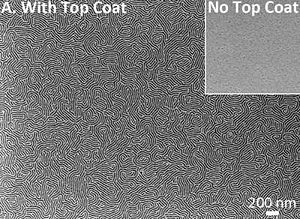Data storage has reached great heights in the past two decades. You can now fit in a typical PC hard-drive thousands of CDs and millions of floppy disks (who else remembers these?). However, magnetic hard drive developers have almost reached the physical limit to where they can cram up data. Researchers at University of Texas at Austin used a novel technique that makes use of self-assembling polymers to create the smallest magnetic dots in the world. Their results show that hard disk storage can be increased by a factor of five.

Magnetic hard drives store information by inscribing zeros and ones as magnetic dots on a continuous metal surface. The closer you position these dots from one another, the more information you can cram inside. However, there’s little room developers can move nowadays as the maximum density of dots has almost been reached. Any closer positioning would cause the dots to become unstable from their neighbors’ magnetic field.
“The industry is now at about a terabit of information per square inch,” said Willson, who co-authored the Science paper with chemical engineering professor Christopher Ellison and a team of graduate and undergraduate students. “If we moved the dots much closer together with the current method, they would begin to flip spontaneously now and then, and the archival properties of hard disk drives would be lost. Then you’re in a world of trouble. Can you imagine if one day your bank account info just changed spontaneously?”
There’s a work around, however. If you can isolate each individual dot from another, then you can bypass the magnetic field issue and increase the dot density, and in turn storage. This is where the scientists worked their magic after they used the directed self-assembly (DSA) – a method pioneered by University of Wisconsin and MIT.
“I am kind of amazed that our students have been able to do what they’ve done,” said Willson. “When we started, for instance, I was hoping that we could get the processing time under 48 hours. We’re now down to about 30 seconds. I’m not even sure how it is possible to do it that fast. It doesn’t seem reasonable, but once in a while you get lucky.
Previous attempts have rendered dot density just enough to double the storage density of disk drives. That’s pretty impressive, but Ellison and co. when way higher. They’ve synthesized block copolymers that self-assemble into the smallest dots in the world — 9 nanometers or just about the size of protein. These were attached to a guided surface which had dots and lines etched on it. While the polymers were self-assembling into position, a special top coat that goes over the block copolymers was introduced. This top coat allows the polymers to achieve the right orientation relative to the plane of the surface simply by heating.
“The patterns of super small dots can now self-assemble in vertical or perpendicular patterns at smaller dimensions than ever before,” said Thomas Albrecht, manager of patterned media technology at HGST. “That makes them easier to etch into the surface of a master plate for nanoimprinting, which is exactly what we need to make patterned media for higher capacity disk drives.”
Now Ellison and his team of graduate students are working together with HGST to see how this process can be implemented in the current manufacturing processes. Their findings were reported in the journal Science.
Is this the farthest we can go with magnetic storage? Well, I wouldn’t worry too much about it, if I were you. Solid State Drives are the next generation of storage mediums, though next generation might not be the best word here since they’ve been commercially available for years, but only recently started to pick up with the public.
Solid state drives are made from silicon microchips and store data electronically instead of magnetically, as spinning hard disk drives or magnetic oxide tape do. Thy’re faster, lighter and a lot more reliable than magnetic hard drives, the only impediment is that they’re currently roughly four times as expensive, but like all things in tech they’ll become reasonable enough for the general public in no time. Say goodbye to your HDD.






